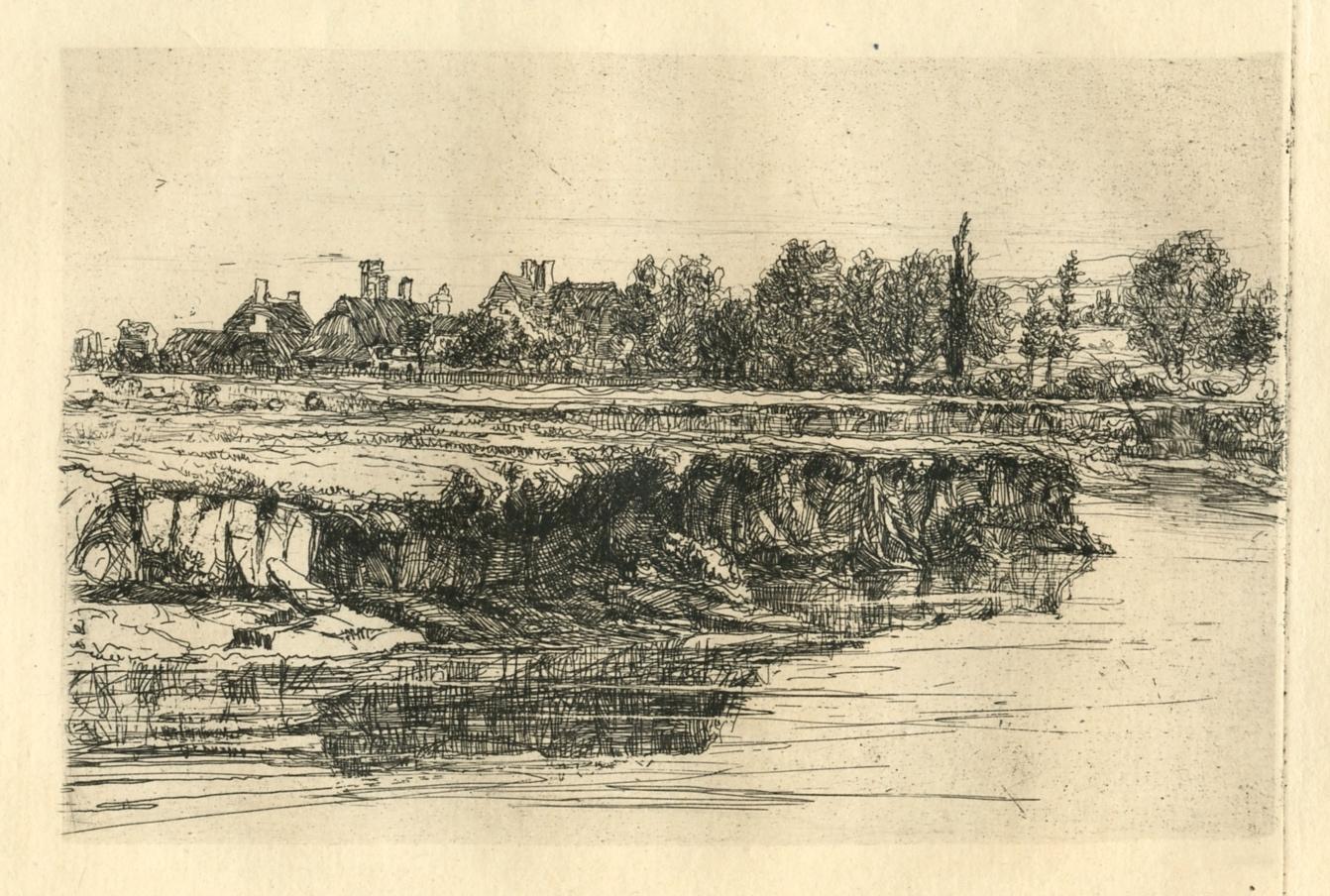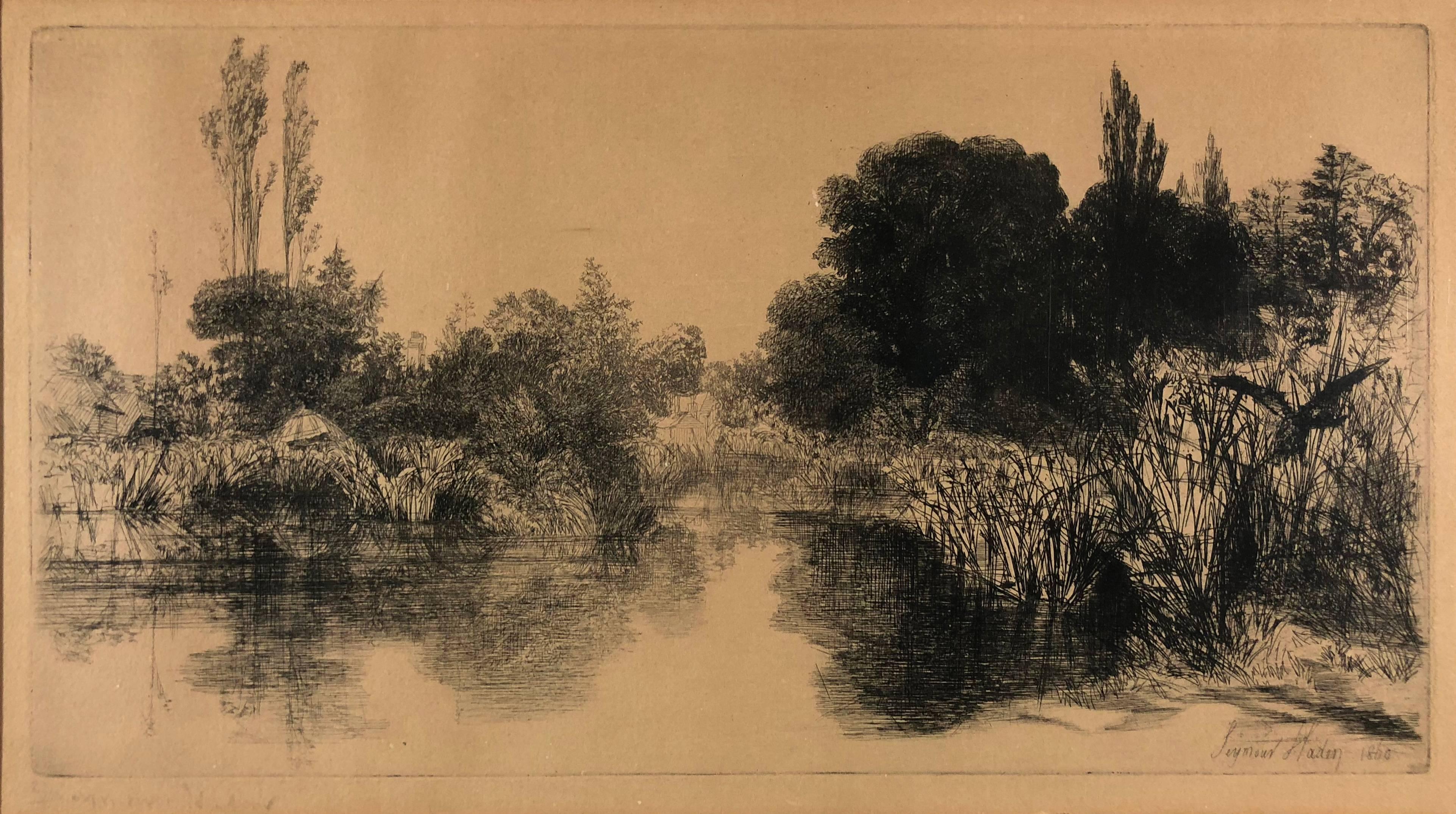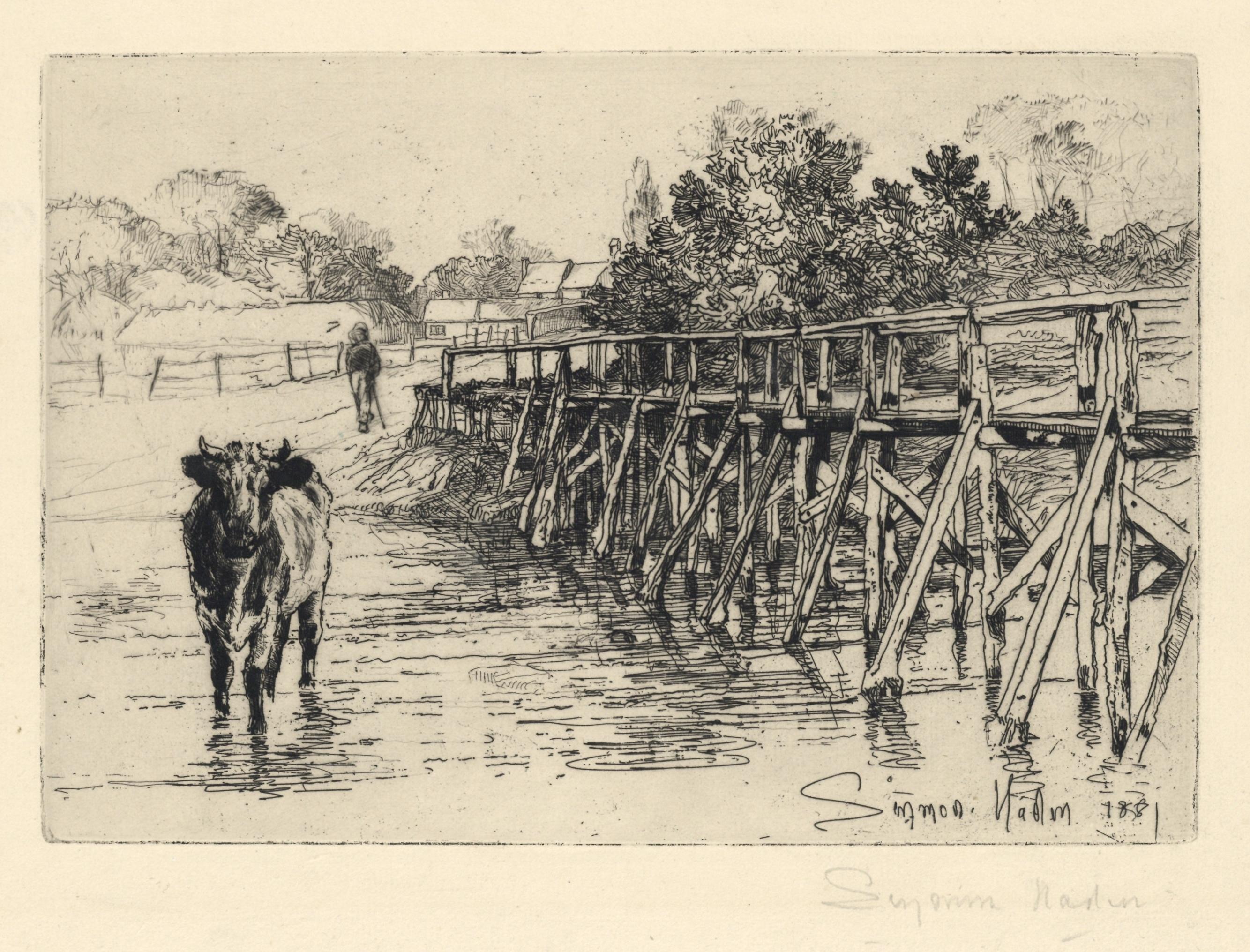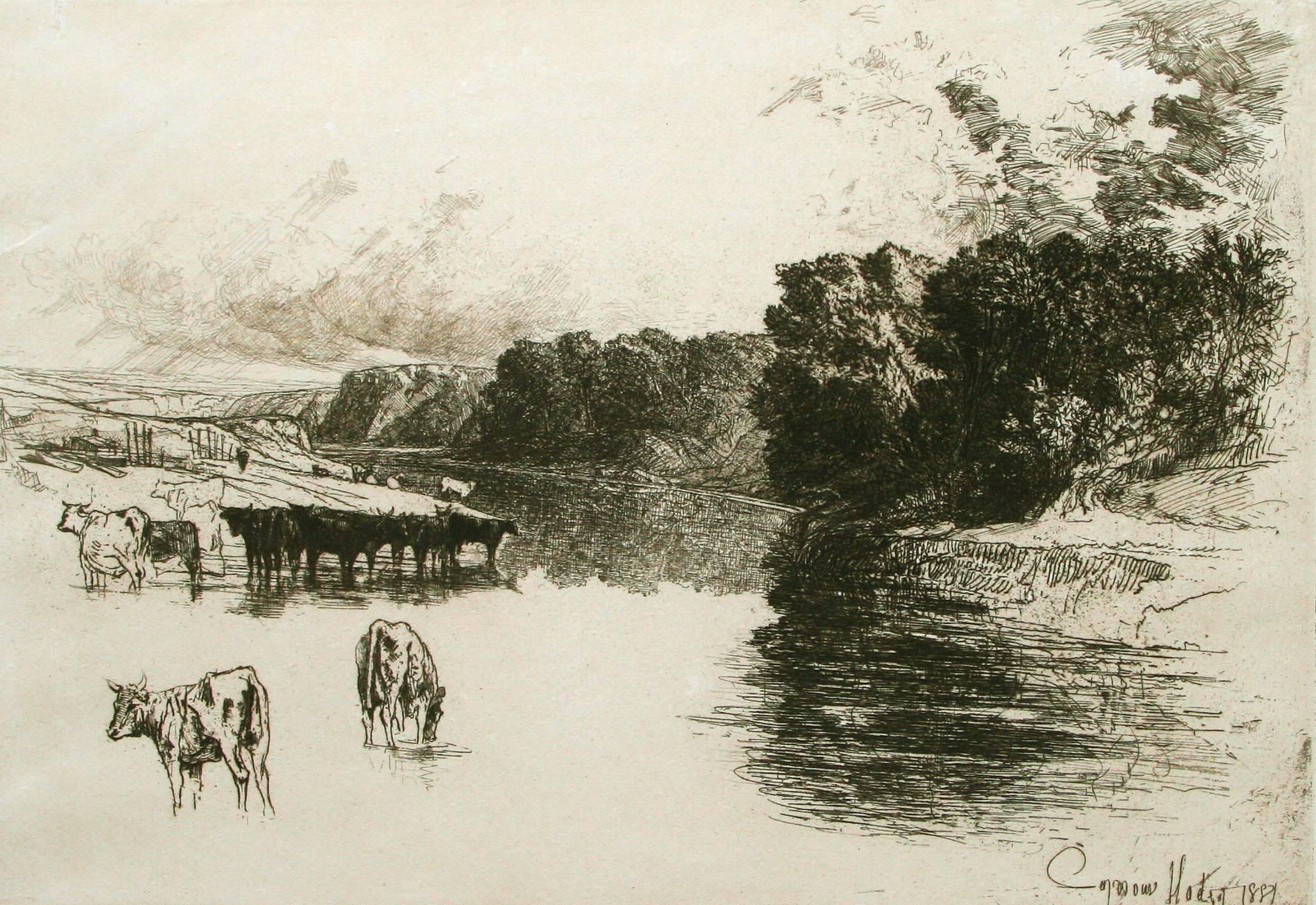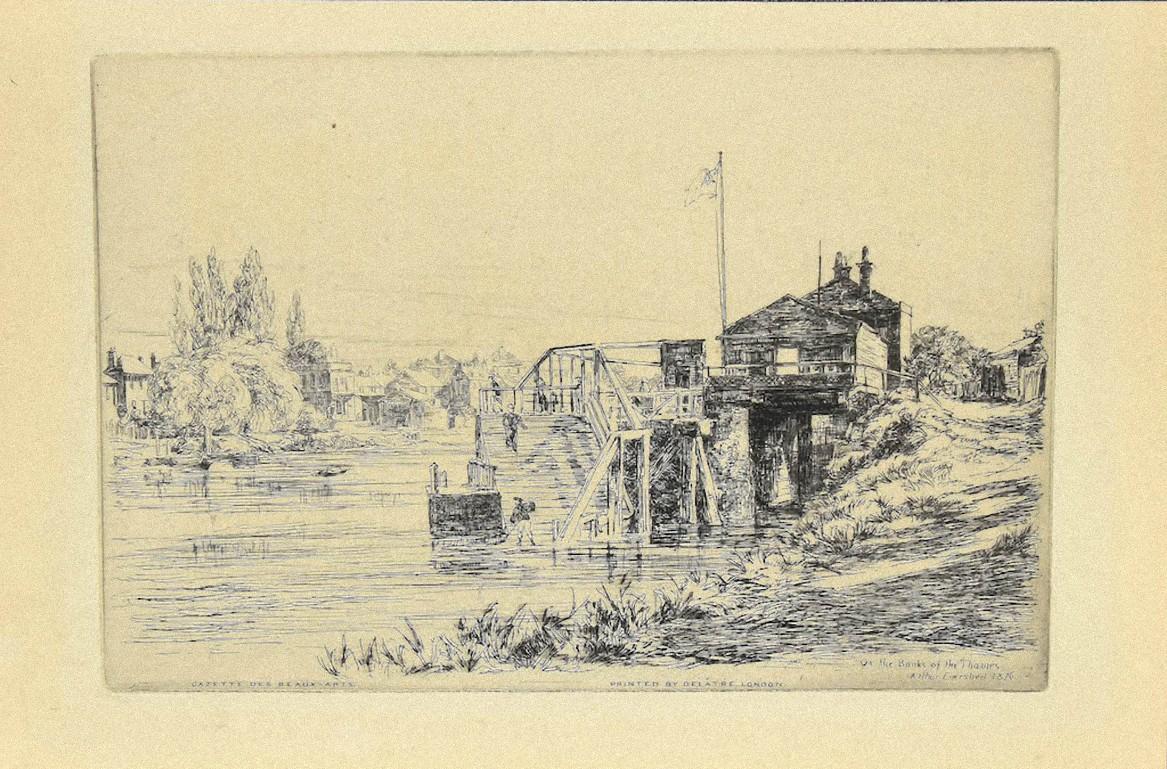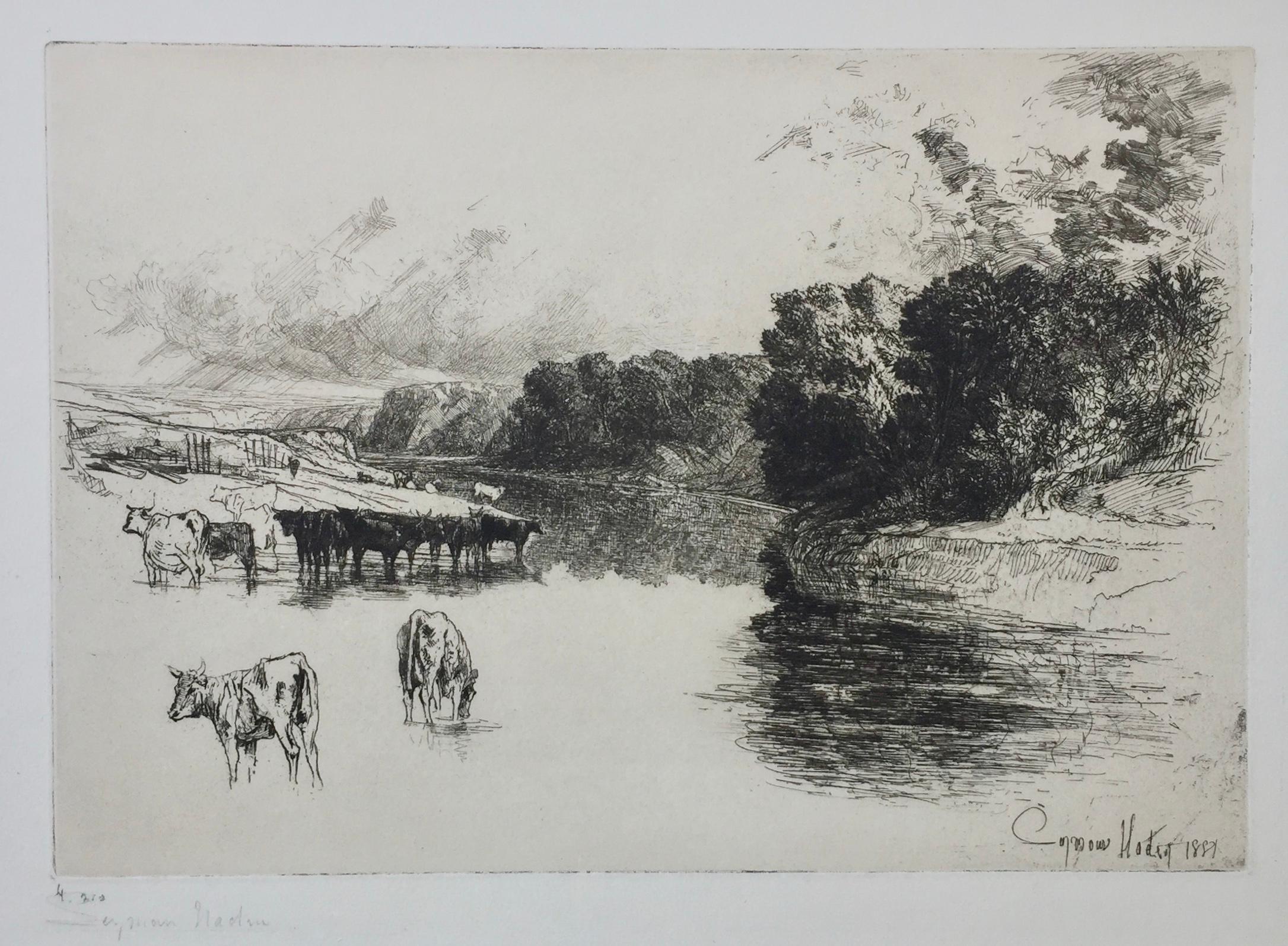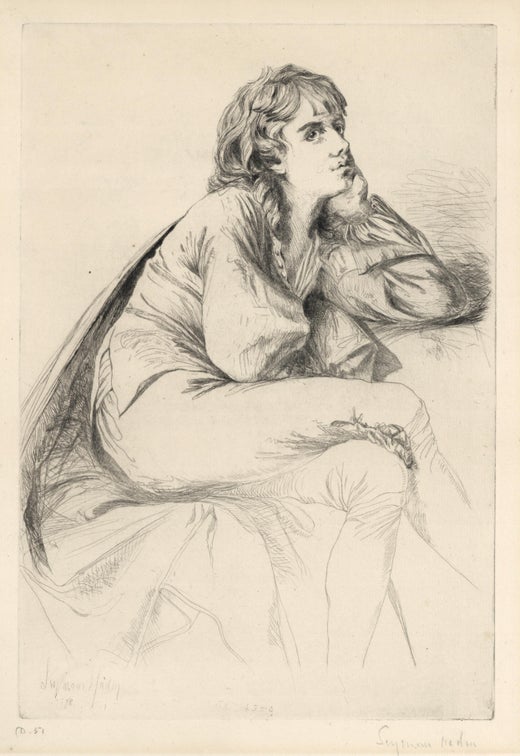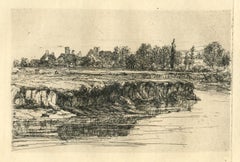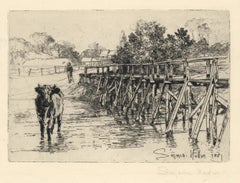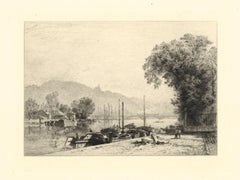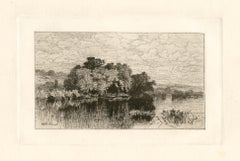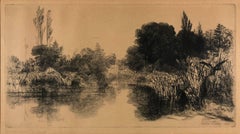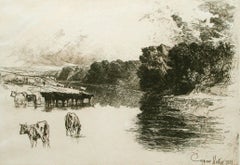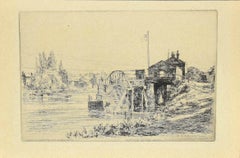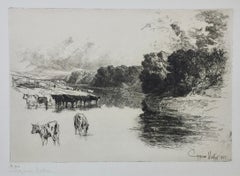Items Similar to "Egham Lock" original etching
Want more images or videos?
Request additional images or videos from the seller
1 of 2
Sir Francis Seymour Haden, R.A."Egham Lock" original etching1859
1859
$300
£233.62
€265.74
CA$432.05
A$474.12
CHF 247.64
MX$5,668.64
NOK 3,136.74
SEK 2,925.60
DKK 1,984.72
About the Item
Medium: original etching. Catalogue reference: Schneiderman 21. Executed in 1859; this very nice impression on thin laid paper is from the Gazette des Beaux Arts edition of 1864. Plate size: 5 7/8 x 8 7/8 inches. Signed by Seymour Haden in the plate, not by hand.
- Creator:Sir Francis Seymour Haden, R.A. (1818 - 1910, British)
- Creation Year:1859
- Dimensions:Height: 5.88 in (14.94 cm)Width: 8.88 in (22.56 cm)
- Medium:
- Period:
- Condition:
- Gallery Location:Henderson, NV
- Reference Number:1stDibs: LU2365215942502
Sir Francis Seymour Haden, R.A.
Sir Francis Seymour Haden CMG FRCS PPRE (16 September 1818 – 1 June 1910), was an English surgeon, best known as an original etcher who championed original printmaking. He was at the heart of the Etching Revival in Britain, and one of the founders of the Society of Painter-Etchers, now the Royal Society of Painter-Printmakers, as its first president. He was also a collector and scholar of Rembrandt's prints.
About the Seller
5.0
Platinum Seller
Premium sellers with a 4.7+ rating and 24-hour response times
Established in 2006
1stDibs seller since 2023
575 sales on 1stDibs
Typical response time: 2 hours
- ShippingRetrieving quote...Shipping from: Henderson, NV
- Return Policy
More From This Seller
View All"Bit of a River Bank" original etching
By Sir Francis Seymour Haden, R.A.
Located in Henderson, NV
Medium: original etching. This impression on laid paper was printed in 1868 for Philip Gilbert Hamerton's very scarce first volume of "Etching and Etchers". Image size: 4 x 6 1/4 inc...
Category
1860s Landscape Prints
Materials
Etching
"The Village Ford" signed original etching
By Sir Francis Seymour Haden, R.A.
Located in Henderson, NV
Medium: original etching. Signed both in the plate and in pencil. Catalogue reference Schneiderman 202. Executed in 1881, and printed on laid paper with full margins. Plate size: 7 x...
Category
1880s Prints and Multiples
Materials
Etching
"On the Seine near Rouen" original etching
Located in Henderson, NV
Medium: original etching. This impression on laid paper was printed in 1882 for the "A Group of Etchers" portfolio and published in New York. Plate size: 6 3/4 x 8 3/4 inches (170 x ...
Category
1880s Prints and Multiples
Materials
Etching
"Mill Pond At Windsor, Connecticut" original etching
By Albert Fitch Bellows
Located in Henderson, NV
Medium: original etching. This impression on laid paper was printed in 1883 and published in Boston by Estes and Lauriat. This composition is also called "July". Plate size: 4 1/4 x ...
Category
1880s Prints and Multiples
Materials
Etching
"Old Mill at Valley Stream" original etching
By Charles Henry Miller
Located in Henderson, NV
Medium: original etching. This bucolic landscape is located in what is now the borough of Queens in New York City. Printed on laid paper in 1880 and published by The American Art Rev...
Category
1880s Prints and Multiples
Materials
Etching
"Near Voudenay" original etching
By Philip Gilbert Hamerton
Located in Henderson, NV
Medium: original etching. This impression on laid paper was printed in London in 1868 for the rare first volume of Philip Gilbert Hamerton's "Etching and Etchers". In addition to bei...
Category
1860s Prints and Multiples
Materials
Etching
You May Also Like
Shere Mill Pond
By Sir Francis Seymour Haden, R.A.
Located in Missouri, MO
Shere Mill Pond, No. II (large plate). 1860. Etching and drypoint. Schneiderman 37.v/ix. 7 x 13 1/8 (sheet 10 3/4 x 16 3/8). This state is prior to publication in Études à l'Eau-Forte. Illustrated: Keppel The Golden Age of Engraving; Print Collector's Quarterly 1 (1911): 18; : Guichard, British Etchers, 1850-1940. A rich, brilliant proof with drypoint burr printed on white laid paper. Signed in pencil.
-------------------------------------------------------------------------------------------
Shere Mill Pond, No. II was one of the most highly praised landscape prints of the etching revival. An impression was exhibited at the Royal Academy in 1861 under Haden’s pseudonym, H. Dean. Francis Seymour Haden used this anagram of his own name early in his career as an artist, in order to retain his anonymity and preserve his professional reputation as a surgeon.
Biography:
Sir Francis Seymour Haden (16 September 1818 - 1 June 1910), was an English surgeon, best known as an etcher.
He was born in London, his father, Charles Thomas Haden, being a well-known doctor and lover of music. He was educated at Derby School, Christ's Hospital, and University College, London, and also studied at the Sorbonne, Paris, where he took his degree in 1840. He was admitted as a member of the College of Surgeons in London in 1842.
In 1843-1844, with his friends Duval, Le Cannes and Colonel Guibout, he travelled in Italy and made his first sketches from nature. Haden attended no art school and had no art teachers, but between 1845 and 1848 he studied portfolios of prints belonging to a second-hand dealer named Love, who had a shop in Bunhill Row, the old Quaker quarter of London. Arranging the prints in chronological order, he studied the works of the great original engravers, Albrecht Dürer, Lucas van Leyden and Rembrandt. These studies, besides influencing his original work, led to his important monograph on the etched work of Rembrandt. By lecture and book, and with the aid of the memorable exhibition at the Burlington Fine Arts Club in 1877, he tried to give a true reflection of Rembrandt's work, giving a nobler idea of the master's mind by taking away from the list of his works many dull and unseemly plates that had long been included in the lists. His reasons were founded upon the results of a study of the master's works in chronological order, and are clearly expressed in his monograph, The Etched Work of Rembrandt critically reconsidered, privately printed in 1877, and in The Etched Work of Rembrandt True and False (1895).
Haden's printmaking was invigorated by his much younger brother-in-law, James Whistler, at the Haden home in Sloane Street in 1855. A press was installed there and for a while Haden and Whistler collaborated on a series of etchings of the Thames. The relationship and project did not last.
Haden followed the art of original etching with such vigour that he became not only the foremost British exponent of that art but brought about its revival in England. His strenuous efforts and perseverance, aided by the secretarial ability of Sir WR Drake, resulted in the foundation of the Royal Society of Painter-Etchers and Engravers. As president he ruled the society with a strong hand from its first beginnings in 1880.
Notwithstanding his study of the old masters of his art, Haden's own plates were very individual, and are particularly noticeable for a fine original treatment of landscape subjects, free and open in line, clear and well divided in mass, and full of a noble and dignified style of his own. Even when working from a picture his personality dominates the plate, as for example in the large plate he etched after J.M.W. Turner's "Calais Pier," which is a classical example of what interpretative work can do in black and white. Of his original plates, more than 250 in number, one of the most notable was the large "Breaking up of the Agamemnon."
An early plate, rare and most beautiful, is "Thames Fisherman". "Mytton Hall" is broad in treatment, and a fine rendering of a shady avenue of yew trees leading to an old manor-house in sunlight. "Sub Tegmine" was etched in Greenwich Park in 1859; and "Early Morning--Richmond", full of the poetry and freshness of the hour, was done, according to Haden, actually at sunrise. One of the rarest and most beautiful of his plates is "A By-Road in Tipperary"; "Combe Bottom" is another; and "Shere Mill Pond" (both the small study and the larger plate), "Sunset in Ireland," "Penton Hook," "Grim Spain" and "Evening Fishing, Longparish," are also notable examples of his genius. A catalogue of his works was begun by Sir William Drake and completed by Harrington in 1880. During later years Haden began to practise the sister art...
Category
Late 19th Century Old Masters Landscape Prints
Materials
Drypoint, Etching
A Lancashire River.
By Sir Francis Seymour Haden, R.A.
Located in Storrs, CT
Schneiderman 203.viii. 10 7/8 x 15 7/8 (sheet 13 7/8 x 17 7/8). Illustrated: Print Collector's Quarterly 1 (1911): 27. A 1-inch printing fold in the left-hand side of the image, and ...
Category
Late 19th Century Landscape Prints
Materials
Etching
On the Bank of Thames - Original Etching on Paper by Arthur Evershed - 1876
Located in Roma, IT
On the Bank of Thames is an original etching artwork on paper realized in 1876 by Arthur Evershed (1836-1919), printed by Delatre London.
Plate-signed on the lower right and dated....
Category
1870s Figurative Prints
Materials
Etching
A LANCASHIRE RIVER,
By Sir Francis Seymour Haden, R.A.
Located in Santa Monica, CA
SIR FRANCIS SEYMOUR HADEN (1818-1910)
A LANCASHIRE RIVER, 1881 (Schneiderman 203 viii/ix; Harrington 215 ii/ii)
Original etching with drypoint. Signed in pencil., image 11 x 16. A large sheet, 18 x 22 inches with 3 inch margins.
In very good condition.
According to British dealer...
Category
1880s English School Landscape Prints
Materials
Etching
Twickenham Church
By Sir Francis Seymour Haden, R.A.
Located in Middletown, NY
A luminous first state impression, Hamerton's "Portfolio" edition. Etching and drypoint on cream wove paper, 7 3/16 x 9 15/16 inches (135 x 213 mm), wide margins. First state (of 5)...
Category
Mid-19th Century Realist Landscape Prints
Materials
Drypoint, Etching
Wareham Bridge
By Seymour Haden
Located in Missouri, MO
Wareham Bridge
Medium Drypoint
Year of Work 1877-1877
Image Size: approx. 6 in.; Width 8.9 in. / Height 15.2 cm.; Width 22.7 cm.
Sir Francis Seymour Haden (16 September 1818 - 1 June 1910), was an English surgeon, best known as an etcher.
He was born in London, his father, Charles Thomas Haden, being a well-known doctor and lover of music. He was educated at Derby School, Christ's Hospital, and University College, London, and also studied at the Sorbonne, Paris, where he took his degree in 1840. He was admitted as a member of the College of Surgeons in London in 1842.
In 1843-1844, with his friends Duval, Le Cannes and Colonel Guibout, he travelled in Italy and made his first sketches from nature. Haden attended no art school and had no art teachers, but between 1845 and 1848 he studied portfolios of prints belonging to a second-hand dealer named Love, who had a shop in Bunhill Row, the old Quaker quarter of London. Arranging the prints in chronological order, he studied the works of the great original engravers, Albrecht Dürer, Lucas van Leyden and Rembrandt. These studies, besides influencing his original work, led to his important monograph on the etched work of Rembrandt. By lecture and book, and with the aid of the memorable exhibition at the Burlington Fine Arts Club in 1877, he tried to give a true reflection of Rembrandt's work, giving a nobler idea of the master's mind by taking away from the list of his works many dull and unseemly plates that had long been included in the lists. His reasons were founded upon the results of a study of the master's works in chronological order, and are clearly expressed in his monograph, The Etched Work of Rembrandt critically reconsidered, privately printed in 1877, and in The Etched Work of Rembrandt True and False (1895).
Haden's printmaking was invigorated by his much younger brother-in-law, James Whistler, at the Haden home in Sloane Street in 1855. A press was installed there and for a while Haden and Whistler collaborated on a series of etchings of the Thames. The relationship and project did not last.
Haden followed the art of original etching with such vigour that he became not only the foremost British exponent of that art but brought about its revival in England. His strenuous efforts and perseverance, aided by the secretarial ability of Sir WR Drake, resulted in the foundation of the Royal Society of Painter-Etchers and Engravers. As president he ruled the society with a strong hand from its first beginnings in 1880.
Notwithstanding his study of the old masters of his art, Haden's own plates were very individual, and are particularly noticeable for a fine original treatment of landscape subjects, free and open in line, clear and well divided in mass, and full of a noble and dignified style of his own. Even when working from a picture his personality dominates the plate, as for example in the large plate he etched after J.M.W. Turner's "Calais Pier," which is a classical example of what interpretative work can do in black and white. Of his original plates, more than 250 in number, one of the most notable was the large "Breaking up of the Agamemnon."
An early plate, rare and most beautiful, is "Thames Fisherman". "Mytton Hall" is broad in treatment, and a fine rendering of a shady avenue of yew trees leading to an old manor-house in sunlight. "Sub Tegmine" was etched in Greenwich Park in 1859; and "Early Morning--Richmond", full of the poetry and freshness of the hour, was done, according to Haden, actually at sunrise. One of the rarest and most beautiful of his plates is "A By-Road in Tipperary"; "Combe Bottom" is another; and "Shere Mill Pond" (both the small study and the larger plate), "Sunset in Ireland," "Penton Hook," "Grim Spain" and "Evening Fishing, Longparish," are also notable examples of his genius. A catalogue of his works was begun by Sir William Drake and completed by Harrington in 1880. During later years Haden began to practise the sister art...
Category
1870s Other Art Style Landscape Prints
Materials
Etching
More Ways To Browse
Vintage Bareback
Vintage Railroad Poster
Warhol Elvis
Yoshida Hiroshi
African American 19th Century
Andy Warhol Elvis
Apres Picasso
Besler Botanical
Bolton Brown
Bordeaux Poster
Bubblegum Art
Cecil Aldin Lithograph
Chicago Art Posters
Erte Suite
Etchings Of Trees
Flintstones Vintage
Francois Desnoyer
German Propaganda Poster
